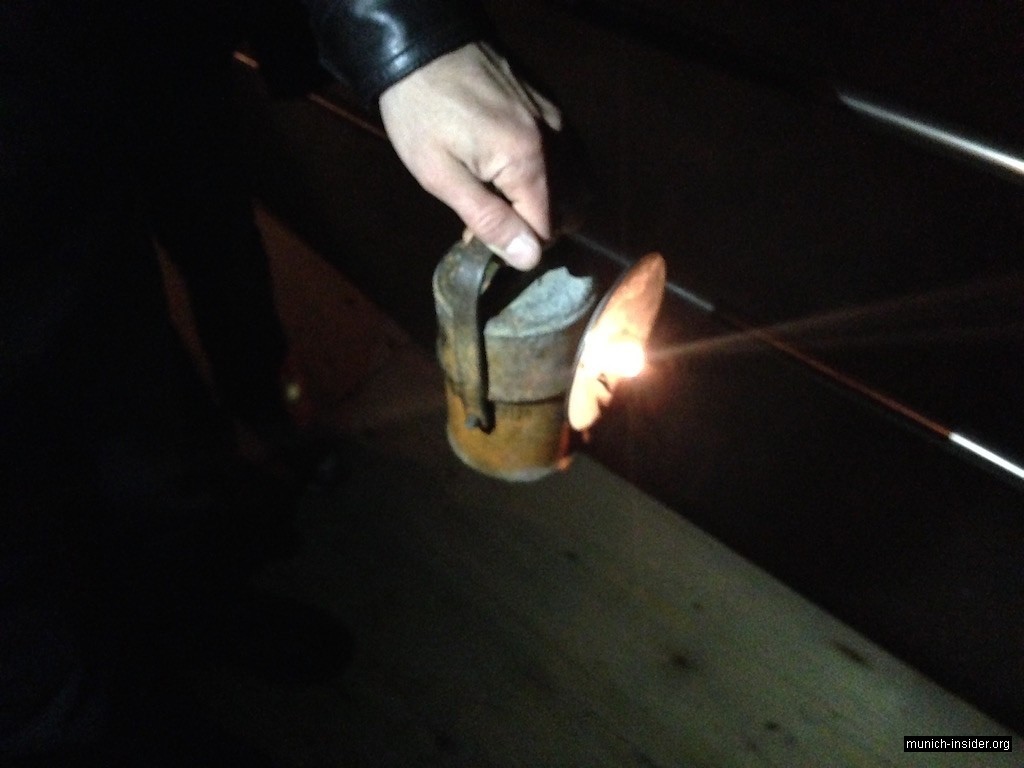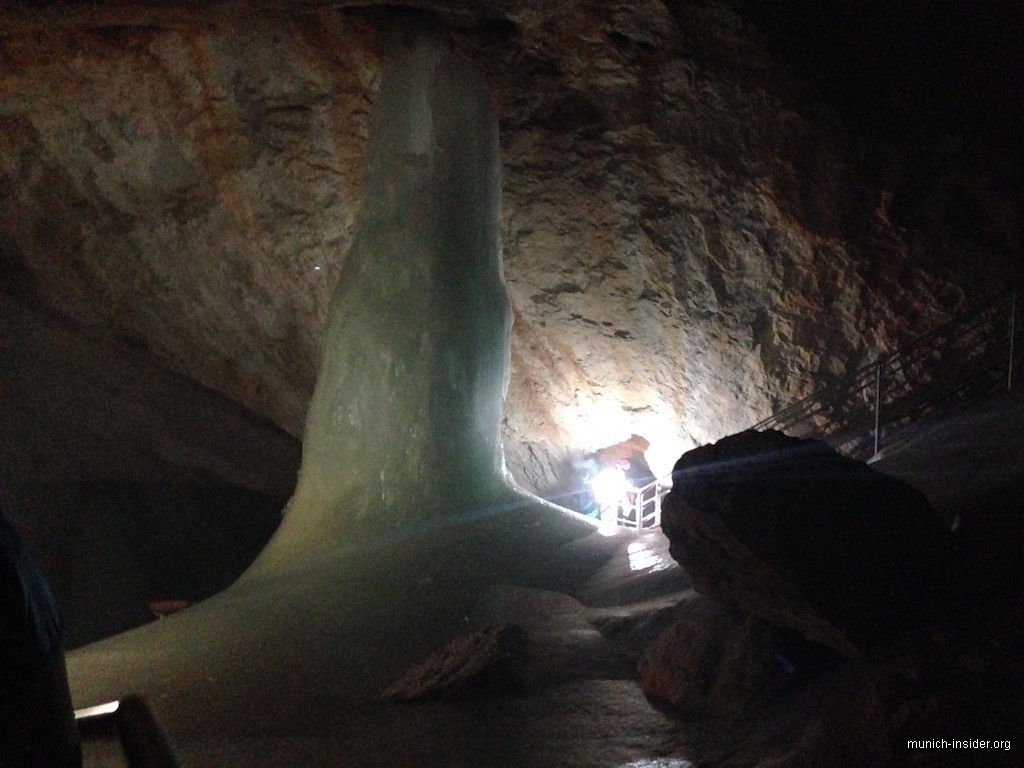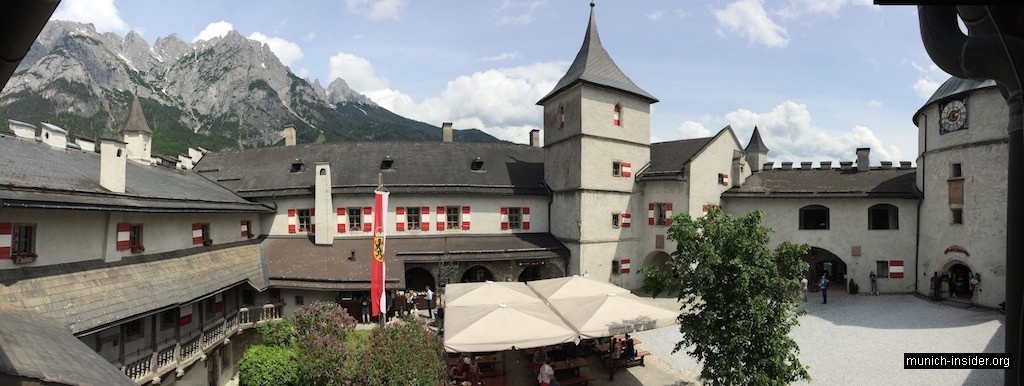Address for GPS: Eishöhlenstrasse 30, 5450 Werfen
Munich to Eisriesenwelt: ~190 km (118 mi), 2.5 hours
Eisriesenwelt – climb and tour: 2 hours
Eisriesenwelt to Hohenwerfen castle: ~ 7 km (4 mi), 20 min
Tour of the Hohenwerfen castle and Falconry show: 2 hours
Total duration: 1 Day
What to see: the Alps, Eisriesenwelt cave, Hohenwerfen castle, Falconry (birds of prey) show
Open map in a new tab
The largest ice cave in the world
True nature lovers strive to explore the most surprising places on our planet, including the underworld. There is an amazing cave in the Alps near Salzburg, about 40 km past it on the road from Munich. Its total length is 42 km (26 miles) and it has been entered into the Guinness Book of Records. Perhaps even longer caves exist elsewhere; however, Eisriesenwelt is the largest among the ice caves, i.e. those where ice does not melt throughout the year. Many tourists come to see this work of nature during the warm season (May to October). In winter, the cave is closed because of the avalanche danger in the mountains.
One weekend in May, we made a trip to this amazing region in the Austrian Alps.
The road from Munich to the cave includes two autobahn segments and a short but winding mountain road. The distance is less than 200 km and it took us two and a half hours to drive there. Generally, it is a real pleasure to drive from Munich to the Alps. The surrounding scenery is astonishing, so driving is an attraction in itself. I have to mention though that one cannot drive straight to the cave entrance which is located at an altitude of 1640 m (5400 feet) and is not accessible by car. Therefore, we left the car on the parking lot which is near the cable car station (see the address above) and bought the tickets for the cable car and a tour of the cave (€22/adult). The cable car ride lasted only a few minutes, but then we had to climb uphill on foot for about 15-20 minutes. So, the first piece of advice to the tourists: wear comfortable shoes suitable for walking in the mountains – the path to the cave is rather steep; moreover, there are significant elevation changes in the cave.
The cave and its ice creations
Finally, we got to the cave entrance. The views of the Alps from this place are just stunning. The entrance to the cave looks mysterious; perhaps because of that in the old time hunters called it the Gateway to Hell. To see in the dark, we were given carbide lamps, so we felt like real speleologists. Of course, the tour does not include walking through the entire cave. In fact, the walking path for visitors stretches for only about a kilometer from the entrance. They say that farther down the cave one can only crawl in many places, so it is not for casual tourists like us. However, I must say that one gets more than enough impressions even in this near-entrance area of the cave.
The first thing you see is huge underground cavities or halls with ice domes and arches, all having different shapes. It is stalagmites formed due to snow melting on the mountain, seeping into the cave and freezing there because of the low temperature. The temperature in the cave is always about 0ºC (32ºF) or below. So, here is the second piece of advice to visitors: dress warmly, even on the hot days. The ice stalagmites were frozen in a variety of forms, resembling something from nature or man-made; so they were given appropriate names: Ice Waterfall, Ice Palace, Ice Organ and so on. It is indeed a beautiful sight, particularly with special lighting strategically placed in the cave. The tour lasted just over an hour. Besides seeing wonderful nature creations, we were told many interesting stories about the speleologists researching the caves. After we exited the cave, the surrounding landscape seemed even more beautiful, perhaps due to the contrast with the dark underworld. We shot a few photos and a short video in the cave, though it is next to impossible to convey in any media the actual impression of the cave. Of course, it is better to see everything with your own eyes.
Hohenwerfen Castle
Just a few kilometers from the Eisriesenwelt cave there is another attraction in the mountains of the Salzburg area – the Hohenwerfen castle. You cannot drive very fast on the mountain road, so it took us about 20 minutes to get there despite its proximity. The Hohenwerfen castle is not only famous for its history and architecture, but also offers a special show for the visitors: falconry. Of course, we could not miss the opportunity to see the Hohenwerfen castle and to attend the falconry show in such an exotic location.
The castle is situated on a steep, 155-meters high hill, so there is a cable car from the parking to the top. They offer guided tours in German every hour and there are audio guides in many languages. The falconry show is held twice a day on the lower court: at 11:15 am and 3:15 pm. Of course, we had already missed the morning show, but we had enough time before the second performance for a tour of the castle. While we were waiting for the start of the tour, we tried some old entertainment – stilt walking. It was fun though rather difficult without practice. Then we were taken into the castle. The tour route goes all the time up, that is, uphill and upstairs. Along the way we entered several round towers and other castle quarters. A lot of medieval weapons are exhibited around: guns, catapults, cannonballs of different diameters, etc. There are also a separate museum of weapons and a torture room with horrendous devices. One might find this exhibition disgusting, but it is somewhat educational how cruel those days were. Note also that for a long time this fortress served as a prison and the inmates were not only common criminals, but also political prisoners, even archbishops. A nice contrast to the torture room exhibits was the magnificent view of the surrounding mountain scenery from the very top of the castle, the bell tower, where the tour ended. Then we went down to the lower courtyard where the falconry show was about to begin.
Falconry show
 Nowadays, such a show in Europe is just for tourists, but in the olden days hunting with birds of prey was popular among the upper classes. It is a curious spectacle, colorful and a lot of fun. Falcon handlers come into a circle one at a time, each with a bird. These guys look very colorful, even flashy – they wear wide-brimmed hats, leather jackets, pants and a glove, which is somewhat similar to a hockey goalie’s glove. Falcons and other raptors take off and land on this glove. I may be mistaken, but almost certainly there were not only falcons, but also hawks and maybe eagles. Birds fly and hover in the air in search of prey. At some point, falconers drag by rope a dummy bait – a woolly or furry wad simulating field mice or other small animals. The birds of prey swiftly throw themselves into a nosedive and grab the bait. The audience is thrilled with this dynamic spectacle. I am not sure though whether the reaction would be the same if it were a live bite. Overall, we liked the show.
Nowadays, such a show in Europe is just for tourists, but in the olden days hunting with birds of prey was popular among the upper classes. It is a curious spectacle, colorful and a lot of fun. Falcon handlers come into a circle one at a time, each with a bird. These guys look very colorful, even flashy – they wear wide-brimmed hats, leather jackets, pants and a glove, which is somewhat similar to a hockey goalie’s glove. Falcons and other raptors take off and land on this glove. I may be mistaken, but almost certainly there were not only falcons, but also hawks and maybe eagles. Birds fly and hover in the air in search of prey. At some point, falconers drag by rope a dummy bait – a woolly or furry wad simulating field mice or other small animals. The birds of prey swiftly throw themselves into a nosedive and grab the bait. The audience is thrilled with this dynamic spectacle. I am not sure though whether the reaction would be the same if it were a live bite. Overall, we liked the show.The trip was very busy and interesting, and it was much to discuss on the way home.
Share on:
 Munich Insider Tips and advice from Munich residents for self-guided tours and trips
Munich Insider Tips and advice from Munich residents for self-guided tours and trips















